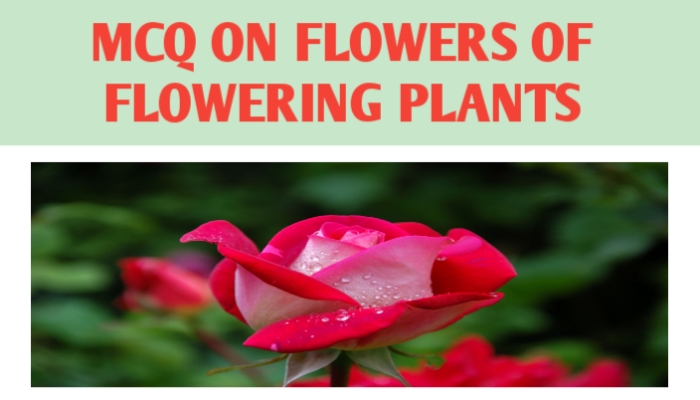MCQ ON FLOWERS OF FLOWERING PLANTS class 11 for NEET | FLOWERS of flowering plant class 11 MCQ | FLOWERS OF FLOWERING with Answer | Check the below NCERT MCQ question for class 11 Biology chapter 5 based on FLOWERS OF FLOWERING PLANTS with Answers.

MCQ ON FLOWERS OF FLOWERING PLANTS
MCQ on FLOWERS of Flowering Plants class 11 Biology with answers were prepared based on the latest pattern. We have provided class 11 Biology MCQs questions on FLOWERS OF FLOWERING PLANTS with Answers to help students understand the concept very well.
MCQ on FLOWERS OF FLOWERING PLANTS is useful for NEET / CSIR / UGC / CBSE / ICSE / AIIMS / EXAM / AFMC EXAM / STATE LEVEL MEDICAL EXAM 2022-23
Introduction:-
The flowers is the reproductive unit in the angiosperms.It is meant for sexual reproduction. A typical flower has four different kinds of whorls arranged successively on the swollen end of the stalk or pedicel , called thalamus or receptacle.These are calyx , corolla, androecium and gynoecium . Calyx and corolla are accessory organs.
MCQ ON FLOWERS OF FLOWERING PLANTS class 11 for NEET
1. The reproductive unit in the angiosperms
(a) root
(b) stem
(c) flower
(d) fruit
Ans (c) flower
2. A typical flower has four different kinds of whorls arranged successively on the swollen end of the stalk or pedicel , called
(a) thalamus
(b) receptacle
(c) both a and b
(d) all the above
Ans. (c) both a and b
3. Accessories organs of flowers are
(a) calyx and corolla
(b) androecium and gynoecium
(c) calyx and androecium
(d) corolla and gynoecium
Ans. (a) calyx and corolla
4. In some flowers like lily , the calyx and corolla are not distinct and are termed as
(a) perianth
(b) corolla
(c) thalamus
(d) all the above
Ans.(a) perianth
5. When flower has both androecium and gynoecium , it is
(a) unisexual
(b) bisexual
(c) actinomorohic
(d) zygomorphic
Ans.(b) bisexual
ALSO READ:-
● YOU CAN WATCH BIOLOGY SIR Youtube channel
6. A flower having either only stamens or only carpels is
(a) bisexual
(b) unisexual
(c) asymmetric
(d) all the above
Ans.(b) unisexual
7. When a flower can be divided into two equal radial halves in any radial plane passing through the centre , it is said to be
(a) actinomorohic
(b) zygomorphic
(c) trimerous
(d) capitulum
Ans.(a) actinomorohic
8. Actinomorohic found in
(a) mustard
(b) datura
(c) chilli
(d) all the above
Ans.(d) all the above
9. When flower can be divided into two similar halves only in one particular vertical plane , it is called
(a) zygomorphic
(b) actinomorohic
(c) asymmetric
(d) all the above
Ans. (a) zygomorphic
10. Zygomorphic found in
(a) pea
(b) gulmohar
(c) bean
(d) all the above
Ans. (b) all the above
11. Asymmetric irregular flowers is found in
(a) canna
(b) pea
(c) gulmohar
(d) all the above
Ans.(a) canna
12. Flowers with bracts reduced leaf found at the base of the pedicel are called
(a) bracteate
(b) ebracteate
(c) unisexual
(d) all the above
Ans.(a) bracteate
13. Based on the position of calyx , corolla and androecium in the respect of the ovary on thalamus , the flowers are described as
(a) hypogynous
(b) perigynous
(c) epigynous
(d) all the above
Ans.(d) all the above
14. In the hypogynous flower the gynoecium occupies the
(a) lower position
(b) highest position
(c) below
(d) all the above
Ans.(b) highest position
15. Hypogynous flower are found in
(a) mustard
(b) china rose
(c) brinjal
(d) all of these
Ans. (d) all of these
16. If the gynoecium is situated in the centre and other parts of the flowers are located on the rim of the thalamus almost same level , it is called
(a) hypogynous
(b) perigynous
(c) epigynous
(d) all the above
Ans.(b) perigynous
17. The margin of thalamus grows upward enclosing the ovary completely and getting fused with it, the other parts of flower arise
above the ovary .
(a) perigynous
(b) epigynous
(c) hypogynous
(d) all the above
Ans.(b) epigynous
18. The outermost whorls of the flower and the members are called
(a) calyx
(b) corolla
(c) androecium
(d) gynoecium
And.(a) calyx
19. The part of flowers are usually brightly coloured to attract insects for pollination. ?
(a) calyx
(b) corolla
(c) androecium
(d) gynoecium
Ans. (b) corolla
20. The mode of arrangement of sepals or petals in Floral bud with respect to the other members of the same whorls is known as
(a) aestivation
(b) epiphyllous
(c) verticillaster
(d) all the above
Ans.(a) aestivation







Leave a Comment